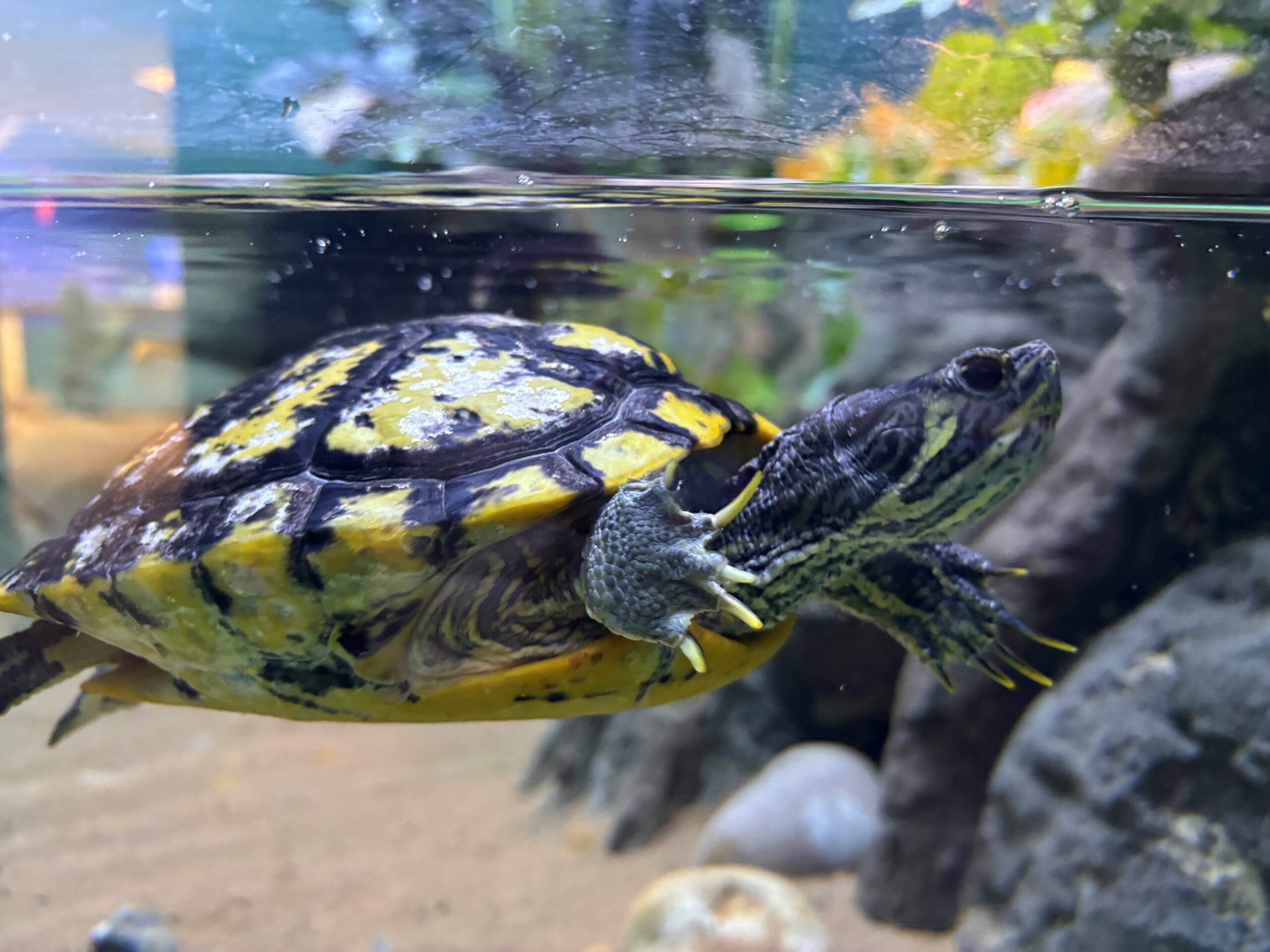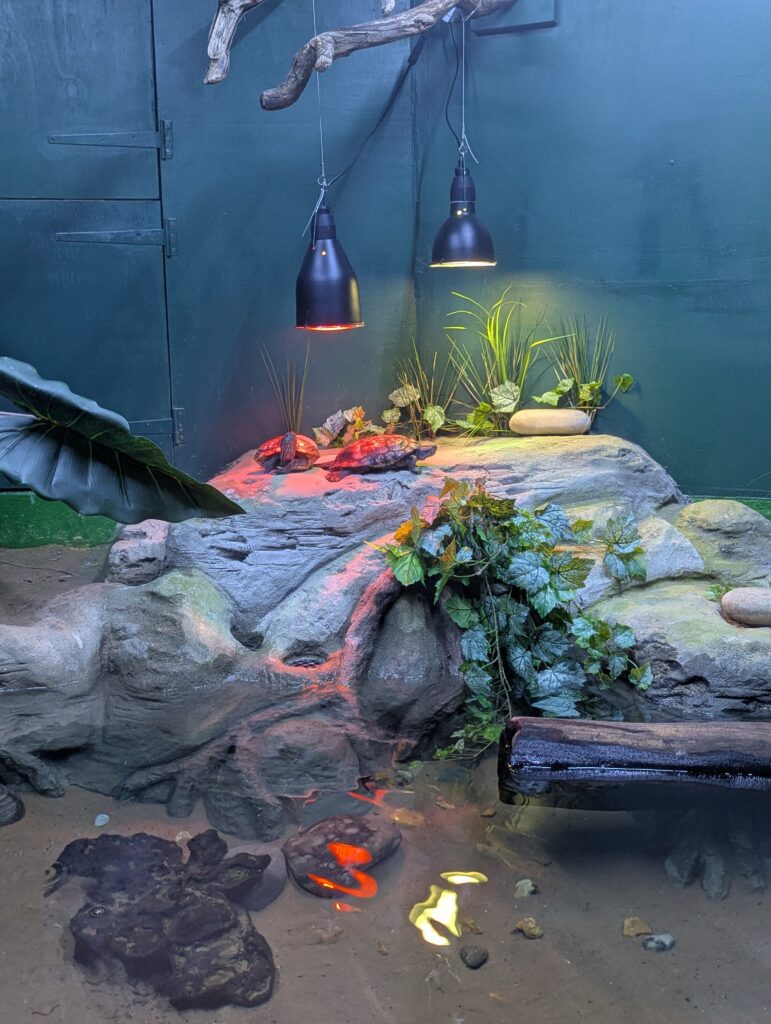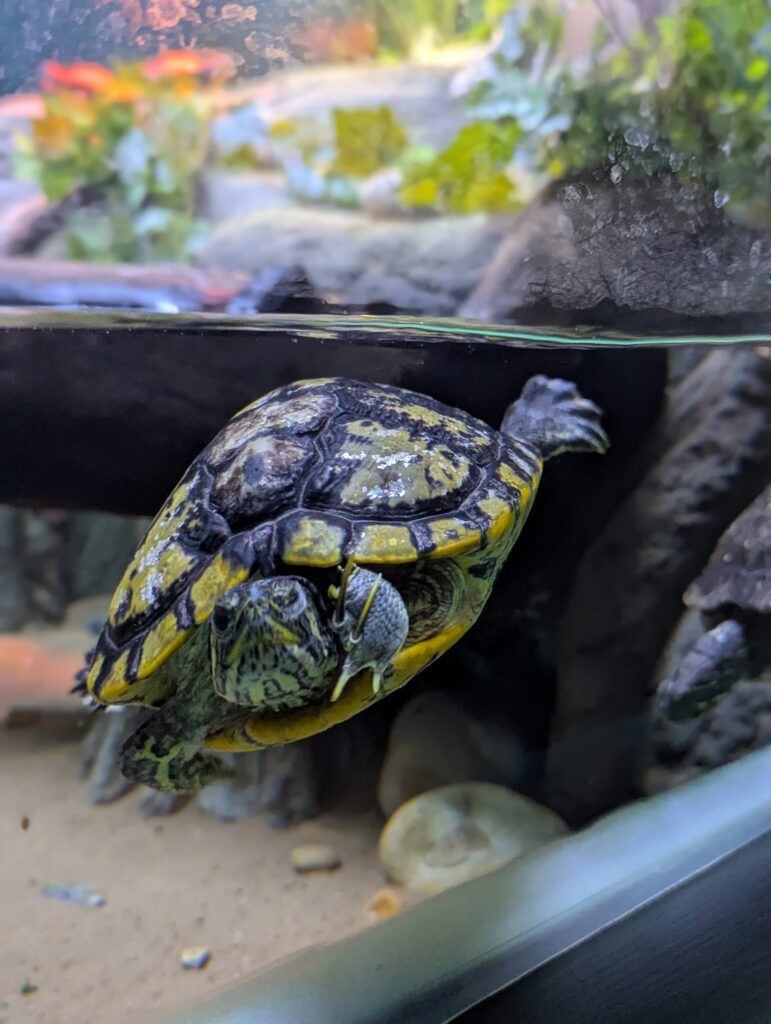
Welcome to the wonderful world of turtles at Blue Reef Aquarium Portsmouth. Here you can learn all about the three freshwater species that live here: the false map turtle (Graptemys pseudogeographica), the red eared slider (Trachemys scripta elegans), and the yellow belly slider (Trachemys scripta scripta).
Ready to explore their unique adaptations? Let’s dive in!
What is a turtle?
Turtles are reptiles that live in a variety of habitats, from saltwater oceans to freshwater rivers and ponds. They are easily recognised by their bony or cartilaginous shells, which protect them from predators. There are over 300 known species of turtles around the world, ranging from the tiny speckled padloper of South Africa to the enormous leatherback sea turtle, which can weigh up to 900kg!
Although they come in many shapes and sizes, all turtles share certain characteristics. They breathe air, lay eggs, and are cold-blooded, meaning their body temperature changes with their environment. Turtles make up about 10 per cent of all reptile species, playing a vital role in their ecosystems by helping to maintain healthy aquatic environments.
Like animals such as whales and dolphins, turtles can hold their breath underwater, but they’re unable to breathe underwater like fish can.
Turtles at Blue Reef Portsmouth
Turtle Creek is home to three species of freshwater turtle at Blue Reef Aquarium Portsmouth, and they’re all incredibly unique. Visitors can take a look at them up close as they bask on logs, swim gracefully, or interact with one another beneath the surface.
False map turtle (Graptemys pseudogeographica)
Appearance
The false map turtle is known for the intricate yellow lines that trace across its olive-brown skin, giving the appearance of a map. Adults usually grow to around 10 to 15 centimetres in shell length, with females being noticeably bigger than males, usually about twice as big. They have a raised ridge running down the centre of their shell and a small notch on their upper jaw, which gives them a slightly pointed face.
Habitat and lifestyle
This species is native to the central United States, where it can be found in rivers, lakes, and slow-moving streams. The false map turtle is semi-aquatic and enjoys basking on rocks or fallen branches. It is an agile swimmer, spending much of its time in the water but regularly coming out to warm itself in the sun.
Diet
The false map turtle’s diet consists mainly of aquatic insects, small crustaceans, and vegetation. It is an opportunistic feeder, taking advantage of whatever food is available in its habitat.
Conservation status
The false map turtle is not currently considered endangered, but like many freshwater species, it faces threats from pollution, habitat loss, and changes to water flow caused by human activity.
Red eared slider (Trachemys scripta elegans)
Appearance
Perhaps the most recognisable freshwater turtle, the red eared slider is named for the distinctive red streak found just behind each eye. Its shell is usually dark green with yellow markings that become more muted with age. Adult females can reach up to 30 centimetres in length, while males are typically smaller.
Habitat and lifestyle
Red eared sliders are native to the southern United States, particularly around the Mississippi River. They are strong swimmers and are often seen basking in groups on logs or rocks. They thrive in warm, calm freshwater environments such as ponds, marshes, and slow-moving rivers.
Diet
These turtles are omnivores, eating both plants and small aquatic animals. Their diet includes aquatic plants, insects, and small fish. Young sliders tend to eat more animal matter, while adults consume a greater amount of vegetation.
Conservation status
The red eared slider is widespread and adaptable. It’s so adaptable that in some regions it has become an invasive species. In fact, it’s listed as one of the most harmful invasive species in the world.
In the wild, its populations are stable, but continued habitat degradation could affect local numbers.
Yellow belly slider (Trachemys scripta scripta)
Appearance
The yellow belly slider gets its name from its bright yellow underside, which contrasts beautifully with its dark green shell. Its skin is marked with striking yellow stripes along the head, neck, and legs. Adult females are generally larger than males, with some reaching up to 30 centimetres in length.
Habitat and lifestyle
This turtle is native to the southeastern United States, often found in slow-moving rivers, swamps, and lakes. Like its relatives, it enjoys basking in the sun and spends a great deal of time both swimming and resting on exposed surfaces near the water.
Diet
Yellow belly sliders are omnivorous, feeding on aquatic plants, algae, insects, and small fish. As they get older, they eat less protein from animal sources and instead feed mainly on vegetation.
Conservation status
The species is considered of least concern, though it faces similar pressures to other freshwater turtles, including pollution and habitat destruction.
See us in Turtle Creek!
You can find all three of these wonderful species in the Freshwater Fun exhibit at Blue Reef Aquarium Portsmouth. Turtle Creek offers an immersive look into the lives of these reptiles, showcasing how they interact with their surroundings and one another in specially designed habitats.
Turtle Creek is just one of the many exciting displays waiting for you at Blue Reef Aquarium Portsmouth. From the calm of the Solent Seas exhibit to the vibrant marine life of the Tropical Treasures exhibit, there is always something new to discover.
Book your tickets now and come face-to-face with the incredible animals that make our aquarium their home.
Type
Reptile
What do they eat?
Omnivores
Size
10-30cm
Water Type
Freshwater
Where are we?
Turtle Creek
See Us At
Freshwater Fun


